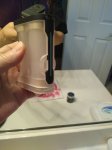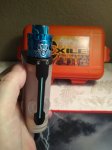Now jist a minute here bub.

This is not a computer forum and I'm not going to get into a long discussion about all this, but with that era of performance computing I KNOW what I am talkin about.
AMD and ATI had not merged yet and at that time Abit motherboards were the best and most popular among enthusiasts. They pioneered the soft bios where you could change the multiplier and the bus speeds in the bios without having to move jumpers on the board itself. Later this expanded to memory timings and susbsystem voltage settings etc. Asus were and are great boards, but Abit ruled that day.
The last really great overclocking Intel processors before AMD released the Athlon architecture were the Celeron 300a and Pentium III 500e.. AMD based platforms were universally preferred among serious overclockers for the next 2 years. It wasn't even close. The thoroughbred and Spitfire core socket 462 processors, especially if you got your hands on the right batch and revision (which I did

) and if you unlocked the L1 multiplier bridges (which I also did

) and even MORE especially if you modded the Abit voltage regulators (which I also did

) ate Intel's lunch in the overclocking department until the release of the P4 1.6a in 2002, which was actually a Northwood core processor. Prescott came later.
AMD's Athlon XP-M 2500+ was an absolute monster of an overclocker. Even with the locked multiplier, due to it's ability to withstand voltages well above it's mobile application spec. As long as you managed the heat which was always the issue with AMD at the time. They would eat themselves in seconds if you didn't
KEEP THEM COOL.
Also yes, ATI had horrible drivers and Nividia's driver crew worked directly with ID software and their Quake 3 engine guys to optimize their drivers for Q3 based games especially, though the Unreal engine was big too. However, the Radeon 9700 Pro did unseat Nvidia's best Geforce cards (The Riva TNT cards were much earlier) for a couple generations. I thought it was a huge mistake when ATI (still independent of AMD) started using the .net programming framework as the platform for their drivers and that idiotic CCC package. While probably smart commercially, it flew in the face of the speed stripping minimalist philosophy of serious do it yourselfers everywhere, including me. They could have at least offered a traditional driver pack as well. (though that would have probably been more work)
Life changed and I got outta the game shortly after that. I simply did not have the money for those expensive parts anymore. I haven't followed really closely since.
I'm not trying to give you a hard time and we're talking about 20 years ago, but you got a couple things wrong there. That doesn't make you a dummy, it just means you got a couple things wrong. Everybody does sometimes, including myself.
















 Woot Woot, my absolute favorite kinda vape mail
Woot Woot, my absolute favorite kinda vape mail 